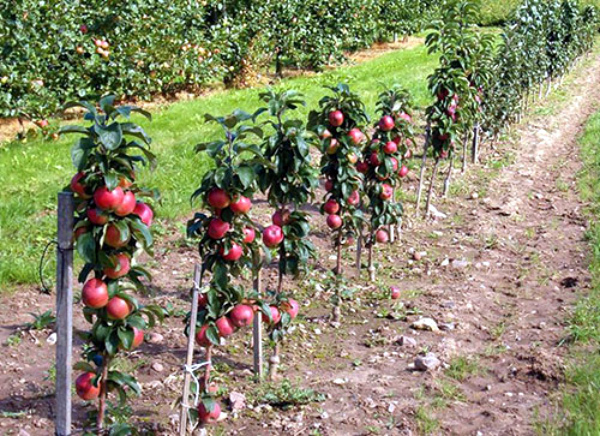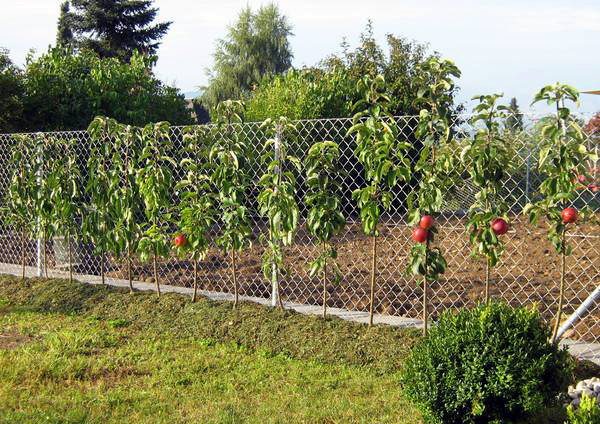Features of growing varieties of columnar apple Vasyugan
Content
Description of the variety
The Vasyugan variety is perfectly zoned for cold regions. High frost resistance makes it suitable for growing in the gardens of Siberia and the Urals. At the same time, the variety is considered one of the most unpretentious among the columnar apple trees.
"Vasyugan" belongs to the semi-dwarf species, reaching a height of about 3 meters. The tree has a dense crown and an abundance of rings on which fruits are formed.
A columnar apple tree bears fruit with large fruits of a rich red-green color weighing up to 200 grams. The average yield per tree is 6-8 kilograms. The variety has a sweet and sour taste, its pulp is fine-grained, juicy, with a light persistent aroma and aftertaste. The harvest can be realized both in conservation and cooking, and by eating fresh apples.
This apple variety brings its first harvest already in the first year of growth in the garden. However, you should not expect a full harvest at this time, only 6-7 apples will ripen. Apple trees bear fruit in full force in the fourth year, if during this time they have not been transplanted again.
The columnar apple tree "Vasyugan" gives a stable harvest for at least fourteen years. However, after that, the harvest declines, so experienced gardeners and breeders recommend updating the garden every ten years. This planting method helps to maintain the same level of fruiting annually.
The variety ripens at the end of August and bears fruit until mid-September. You can keep apples fresh for one and a half months, subject to the general storage rules - a cool place without high humidity.
Growing features
Speaking about growing apple trees of any kind (and it does not matter whether it is columnar or dwarf), you should start with planting, because this is the basis of the foundations, which largely affects the further development and fruiting of the tree. Vasyugan apple trees are planted in pits at least 90 centimeters deep, keeping at least 40 centimeters of free space between the seedlings for free formation and development of the root system, while I leave 1 meter of free space between the rows to provide free access to trees.
The soil must be fertile, saturated with mineral and organic trace elements. It is important that in the area set aside for the apple orchard, the groundwater does not lie very close to the surface.
Before planting, it is necessary to carefully spread the roots of the seedling, and fill the hole with a mixture of humus and the top layer of soil, so that the roots do not come into contact with fertilizers, since this can cause them to burn. The pit is moistened, a seedling is placed in it, covered with earth, and then watered again and tied up with the stem of the seedling to protect it from the wind.
Strawberries or crops can be planted in the aisles or between trees. This will help retain moisture in the soil during the dry summer months.
Care
First of all, a columnar apple tree requires regular watering.At the same time, situations in which moisture accumulates in the soil should be avoided, since this negatively affects the state of the root system and creates favorable conditions for the development of fungal diseases.
This variety practically does not need to be shaped and cut, since with an intact apical bud, only one shoot is formed annually as a continuation of the guide. If, due to frost or disease, the apical bud is damaged, then the columnar apple tree releases several shoots. Of these, only the strongest and most developed should be left, and the rest should be cut off. Do not forget to cover the cut with lime to protect the tree from infections and the development of diseases.
Twice a year, in the spring (before the buds bloom) and in the fall (after the fruiting ends and the leaves fall off), it is necessary to treat the trees with fungicides and insecticides. This will help protect apple trees from diseases and harmful insects, which significantly reduce the quantity and quality of the crop. It's also important to weed out the weeds so they don't take away nutrients. For the winter, the trunks are wrapped with covering material to protect them from hares and rodents.
The columnar apple tree requires several dressings throughout the year. Usually, a solution of mullein or horse manure and an infusion of chicken droppings are used. However, the variety also accepts fertilizing with complex fertilizers, which can be purchased in garden stores. The first feeding is carried out in May, and then every two weeks. After dressing, you can mulch the trunk circle to keep moisture and nutrients in the soil longer. Also, in early spring (before the buds appear), trees are watered with a urea solution, and before flowering, with potassium-phosphorus mixtures.
Disease and pest control
The variety is highly resistant to two main diseases affecting apple trees - scab and powdery mildew. He also has a high resistance to various insects that harm the leaves and branches of apple trees. However, high resistance does not mean that the tree is completely invulnerable, and it is not necessary to carry out preventive treatments every year. Monitor the condition of the leaves, which are often occupied by green aphids and apple leafworms. Preventive treatments can be carried out with the drugs "Nitrofen" and "Enterobacterin".
The variety requires covering the trunks and sometimes even the crown with special protective materials so that the ringlets and bark do not become food for hares and mice.
Video "Apple-tree columns" Vasyugan "," President "and" Dialogue "
This video provides a small overview and comparison of the fruiting columnar apple trees "Vasyugan", "President" and "Dialogue".




